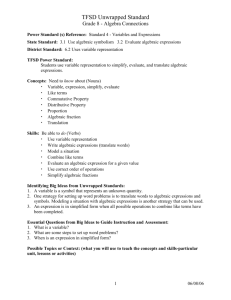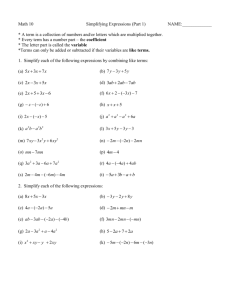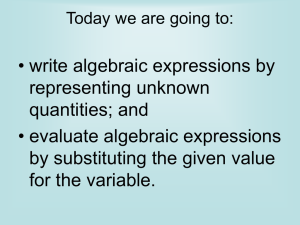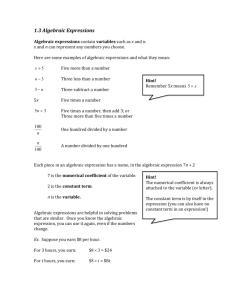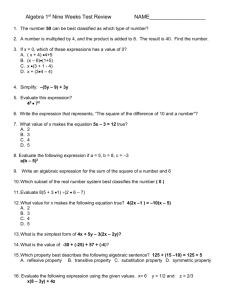Content Notes - Do Math Together
advertisement
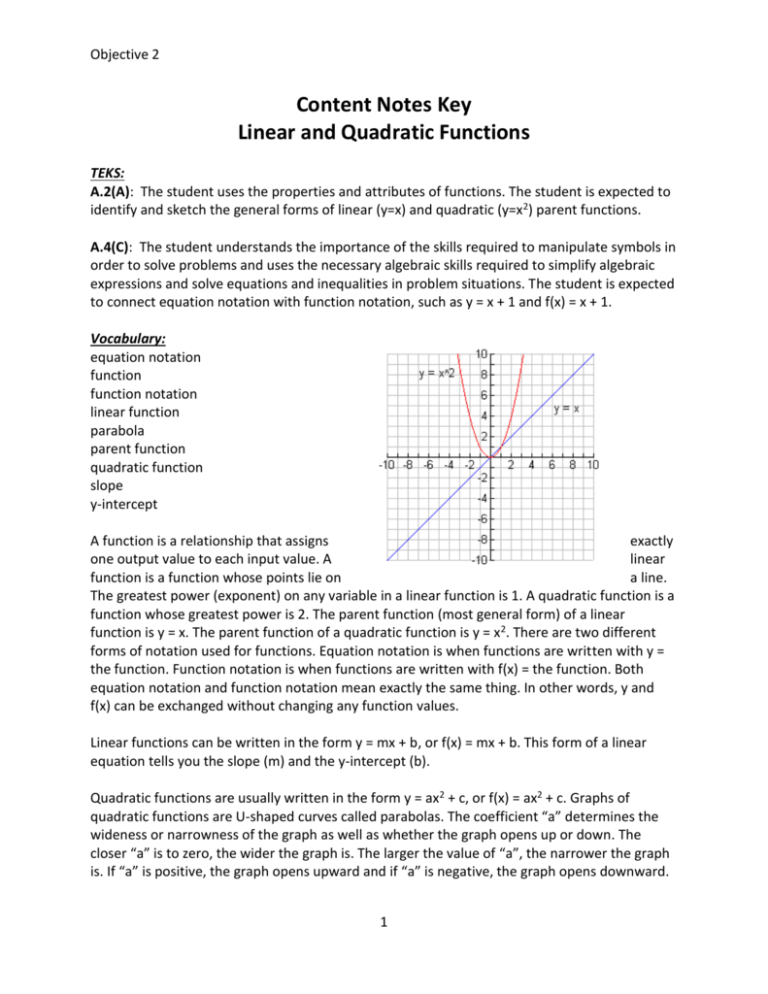
Objective 2
Content Notes Key
Linear and Quadratic Functions
TEKS:
A.2(A): The student uses the properties and attributes of functions. The student is expected to
identify and sketch the general forms of linear (y=x) and quadratic (y=x2) parent functions.
A.4(C): The student understands the importance of the skills required to manipulate symbols in
order to solve problems and uses the necessary algebraic skills required to simplify algebraic
expressions and solve equations and inequalities in problem situations. The student is expected
to connect equation notation with function notation, such as y = x + 1 and f(x) = x + 1.
Vocabulary:
equation notation
function
function notation
linear function
parabola
parent function
quadratic function
slope
y-intercept
A function is a relationship that assigns
exactly
one output value to each input value. A
linear
function is a function whose points lie on
a line.
The greatest power (exponent) on any variable in a linear function is 1. A quadratic function is a
function whose greatest power is 2. The parent function (most general form) of a linear
function is y = x. The parent function of a quadratic function is y = x2. There are two different
forms of notation used for functions. Equation notation is when functions are written with y =
the function. Function notation is when functions are written with f(x) = the function. Both
equation notation and function notation mean exactly the same thing. In other words, y and
f(x) can be exchanged without changing any function values.
Linear functions can be written in the form y = mx + b, or f(x) = mx + b. This form of a linear
equation tells you the slope (m) and the y-intercept (b).
Quadratic functions are usually written in the form y = ax2 + c, or f(x) = ax2 + c. Graphs of
quadratic functions are U-shaped curves called parabolas. The coefficient “a” determines the
wideness or narrowness of the graph as well as whether the graph opens up or down. The
closer “a” is to zero, the wider the graph is. The larger the value of “a”, the narrower the graph
is. If “a” is positive, the graph opens upward and if “a” is negative, the graph opens downward.
1
Objective 2
The “c” value will determine the y-intercept of the graph. A positive “c” value will move the
parabola above the origin, while a negative “c” value will move the parabola below the origin.
Example 1:
Make a table of values and graph for the
relation y = 2x2 + 3.
X
-2
-1
0
1
2
3
Y
11
5
3
5
11
21
1. Is this relation a function? Why or why not? Yes, this relation is a function because
every input has a distinct output.
2. Is this linear or quadratic? Why? Quadratic because the highest exponent is 2. The
graph is a parabola.
3. Is the graph wider or narrower than y = x2? Why? Narrower because the “a” value is 2.
4. Is the graph above or below the origin? Why? Above because the “c” value is positive 3.
5. Find f(6) 75 and f(10). 203
2
Objective 2
Example 2:
Make a table of values and graph for
relation y = 2x – 2.
X
-2
-1
0
1
2
3
the
Y
-6
-4
-2
0
2
4
1. Is this relation a function? Why or why not? Yes, this relation is a function because
every input has a distinct output.
2. Is this linear or quadratic? Why? Linear, the highest exponent is 1. The graph is a
straight line.
3. What is the slope? 2 y-intercept? -2
Example 3:
Given the following table, find the
function that generates these values and
graph the equation.
X
-1
0
1
2
3
4
Y
-9
-6
-3
0
3
6
1. What is the slope? 3 y-intercept? -6
2. What is the function that represents this pattern? y = 3x – 6
3
Objective 2
Generating Equations
TEKS:
A.3(A): The student understands how algebra can be used to express generalizations and
recognizes and uses the power of symbols to represent situations. The student is expected to
use symbols to represent unknown variables.
A.3(B): The student understands how algebra can be used to express generalizations and
recognizes and uses the power of symbols to represent situations. The student is expected to
look for patterns and generalizations algebraically.
Vocabulary:
algebraic expression
equation
pattern
variable
Letters, numbers, and symbols are used to create simplified models of mathematical problems.
These models are called algebraic expressions. An equation is a mathematical sentence that
states two expressions are equal. A variable is a symbol that stands for a number. A variable can
either stand for the number of something or the amount of something. For example, x can
represent the number of hours you work and y can represent the amount of money you make.
To write an algebraic expression, chose variables to represent unknown values.
Example 1:
The length of a square is (x – 3). Write an algebraic expression for the area.
(x-3) 2 = x2 – 6x - 9
Example 2:
Teya got a job selling shoes. She makes $6.25 an hour plus a 5% commission on the shoes that
she sells.
1. What does x represent in this situation? The number of hours Teya works
2. What would y represent in this situation? The amount of money Teya makes
3. Write an equation that models this situation. y = 6.25x + 0.05s
4. How much would Teya make if she worked 10 hours and sold $400 worth of shoes?
$82.50
4
Objective 2
Example 3:
Write an equation that models the data in the table. y = 2x + 2
X
Y
-1
0
0
2
1
4
2
6
Example 4:
Given the sequence, 1, 1, 2, 3, 5, 8..., answer the following questions.
1. What number comes next? 13
2. What is the 10th term? 55
5
Objective 2
Interpret Graphs and Situations
TEKS:
A.2(B): The student uses the properties and attributes of functions. The student is expected to
identify mathematical domains and ranges and determine reasonable domain and range values
for given situations, both continuous and discrete.
A.2(C): The student uses the properties and attributes of functions. The student is expected to
interpret situations in terms of given graphs or create situations that fit given graphs.
A.2(D): The student uses the properties and attributes of functions. The student is expected to
collect and organize data, make and interpret scatterplots (including recognizing positive,
negative and no correlation for data approximating linear situations), and model, predict, and
make decisions and critical judgments in problem situations.
Vocabulary:
continuous
discrete
domain
range
scatterplot
There are many different ways to graph data. Depending on the type of data, you could have a
continuous graph or a discrete graph. A continuous graph has connected lines or curves. All of
the points that lie on the lines or curves are possible solutions to the situation. A discrete graph
contains only distinct points as solutions. For example, if you are looking at a graph of the
number of people that visit the library every day for a given week, your graph would be
discrete. Since it is physically impossible to have ½ of a person visit the library, a continuous
graph would not make sense.
Domain and range are two key aspects of any relation or function. The domain is the set of all
input values for a relation or function. On the coordinate plane, the domain is the set of xvalues (first coordinates). The range is the set of all output values for a relation or function. On
the coordinate plane, the range is the set of all y-values (second coordinates).
6
Objective 2
Example 1:
Determine the domain and range of the given data set.
{(-1, 4), (2, 0), (-3, 4), (0, 5)}
Domain: {-3, -1, 0, 2}
Range: {0, 4, 5}
Example 2:
Write a possible scenario for the given graph. Make sure that you pay attention to the units on
the axes.
Answers will vary. Possible answer; the height
of a candle as it burns over 9 hours.
Example 3:
Draw a graph of distance from Jacob’s
house versus time that could fit the
given scenario.
Jacob leaves his house riding his bike for
minutes to his friend Ryley’s house. He
stops for 10 minutes to talk to him. He
leaves to go back home and arrives
home 5 minutes later.
5
then
then
Answers will vary. See graph.
7
Objective 2
Example 4:
Use the following scatterplot of age (years) versus height (inches) to answer the questions.
1. What is the domain for this data? {5-15}
2. What is the range for this data? {36-65}
3. What type of correlation exists (if any) with this data? positive
4. Draw a line through the origin that fits as many of the points as possible.
5. Estimate the height of a 17 year old. Answers will vary. Between 65 and 70 inches.
8
Objective 2
Solving Equations
TEKS:
A.4(A): The student understands the importance of the skills required to manipulate symbols in
order to solve problems and uses the necessary algebraic skills required to simplify algebraic
expressions and solve equations and inequalities in problem situations. The student is expected
to find specific function values, simplify polynomial expressions, transform and solve equations,
and factor as necessary in problem situations.
A.4(B): The student understands the importance of the skills required to manipulate symbols in
order to solve problems and uses the necessary algebraic skills required to simplify algebraic
expressions and solve equations and inequalities in problem situations. The student is expected
to use the commutative, associative, and distributive properties to simplify algebraic
expressions.
Vocabulary:
associative property
commutative property
distributive property
factor
like terms
An algebraic expression is a combination of numbers, operations, and one or more variables.
Mathematical properties and the order of operations are used to simplify expressions.
Property
Commutative Property
Associative Property
Distributive Property
Description
You can add or multiply numbers
in any order.
When you are only adding or
multiplying, you can group any of
the numbers together.
You can multiply a number by a
sum or multiply the number by
each number in the sum and
then add.
9
Algebra
a+b=b+a
ab = ba
a+b+c
abc
= (a + b) + c
= a(bc)
= a + (b + c)
= (ab)c
a(b + c) = ab + ac
Objective 2
Example 1:
1. The width of a rectangle is 3 feet longer than twice the length. If the length is x feet,
write an expression for the width of the rectangle.
2x + 3
2. Write an expression for the area of the rectangle. A = 2x2 + 3x
3. If the area is 65 ft2, what is the length of the rectangle? 5 feet
4. What is the width? 13 feet
Example 2:
A triangle has a height of x inches and an area of x2 – 3x inches squared.
Find an expression for the base in terms of x. x – 3
If the area is 10 in2, what is the value of x? 5
Example 3:
Simplify 4(2x + 3) – (x - 2)2. –x2 + 12x +8
Example 4:
The area of a rectangle is 3x2 + 22x – 16. The length is (3x – 2). Find the width.
(x + 8)
Example 5:
Given the function f(x) = 2x2 + 3x – 5, find f(4). 39
Example 6:
Solve x2 – x – 6 = 0. x = -2 and x = 3
10


